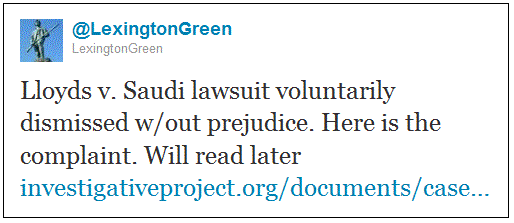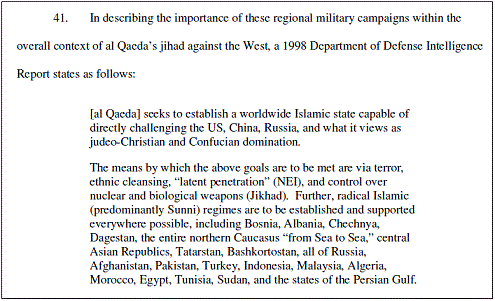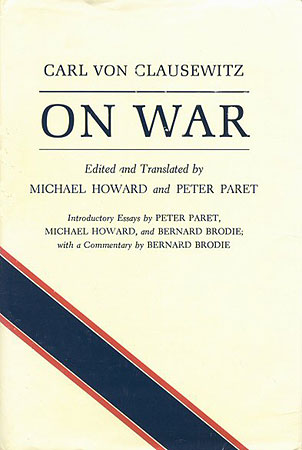[ by Charles Cameron — cross-posted from Chicago Boyz – a meander on the perils and promise of research, jihad, typos, books and more ]
.
It begins with an email from Lexington Green saying I might be interested in a tweet he had posted earlier this morning:

The Insurance Journal tells us:
Defendants named in the complaint were Kingdom of Saudi Arabia, The Saudi High Commission for Relief of Bosnia & Herzegovina, Saudi Joint Relief Committee for Kosovo and Chechnya, Saudi Red Crescent Society, National Commercial Bank, Al Rajhi Banking and Investment Company. Also included as defendants are three Saudi citizens connected to these organizations, Prince Salman Bin Abdul Aziz Al Saud, Suleiman Abdel Aziz Al Saud and Yassin Al Qadi.
The case is Underwriting Members of Lloyd’s Syndicate 3500 v. Kingdom of Saudi Arabia, 11-00202, U.S. District Court, Western District of Pennsylvania.
Okay, I’m curious. I go to the complaint [.pdf] and start reading… and on page 9, I find:

That’s interesting. A DIA report, better look that up. But there’s no reference provided…
So I googled for “latent penetration” NEI which sent me back to versions of the court filing, and then for “latent penetration” and found that Robert W. Schaefer on p. 166 of his book, The Insurgency in Chechnya and the North Caucasus: From Gazavat to Jihad, quotes [with minor variations] from what is obviously the same DIA document and in footnote 29, p 165 identifies it as “Declassified DIA intelligence report NC 3095345, October 16, 1998, 3 (obtained through the Freedom of Information Act).”
Onwards to locate NC 3095345, which can be found here [.pdf] and contains the following relevant text on p. 3:

So that’s the source of the description of AQ’s overall plan in the Lloyds complaint.
But what’s “latent penetration”? The DIA document even has it in quote marks – does that make it a technical term?
Back to Google.
The FBI uses the term “latent penetration” – maybe I’m onto something! In their Electronic Biometric Transmission Specification (EBTS) [.pdf] on p. 58 they offer the “following list of TOTs is applicable to latent friction ridge searches transmitted to the FBI”:

I have to admit – a Latent Penetration Query sounds like just the thing I’m after – but the FBI appears to think of “latent penetration” in terms of fingerprints…
Okay, next up. A quick look at David Waterman and Andrew A. Weiss‘ book, Vertical Integration in Cable Television, (AEI, 1997) tells us:

That’s all a bit above my head, and in any case I don’t watch cable TV… and the networks in question aren’t terrorist networks, they’re cable networks…
When I add the word “terror” into my search, however, I get directed to Prof. Kostogryzov Andrey‘s paper [.ppt] addressing the question of a “methodical approach for the evaluation of systems vulnerability in conditions of terrorist threats” for a symposium at the University of Texas, Arlington – which sounds promising.
Searching the good professor’s powerpoint for “latent penetration” takes me to slide 36, however, where I read:

To be honest with you, I don’t feel any closer to understanding “latent penetration” beyond a sort of general “potentially getting inside the opposition” kind of sense.
So let’s get back to NEI – which is what the Lloyds transcription has in parens immediately after the quote-marked phrase “latent penetration” – what’s that about?
Well, on closer examination, it looks as though Lloyds got that wrong, and the DIA document — compare their E’s and F’s in the typed excerpt above and I think you’ll agree — actually says NFI…
Phew! NFI.
What’s that?
The DIA probably classifies its acronyms, but this particular document has been declassified and NFI hasn’t been redacted, so perhaps the Free Dictionary acronym finder will be able to help…
I quickly dismiss such possibilities as National Fatherhood Initiative and get down to my three basic possibilities:
NFI … No Further Information (available)
NFI … National Foreign Intelligence
NFI … No Freaking Idea
The last of these describes my own feelings at this point, although “freaking” would be the milder way to put it. So it’s down to guesswork: I’ll go with #2.
Okay: according to this particular DIA report, AQ “seeks to establish a worldwide Islamic state” by means that include “latent penetration” — I still have only the vaguest idea [OTVI] what that means — and “control over nuclear and biological weapons (Jikhad)”.
Jikhad?
The DIA docu self-describes thus:

Variant spellings, okay…
But I’m wondering if “Jikhad” is one of them…
Back to the search engines, where I discover the word does have prior art in a terrorist – indeed, a specifically AQ — context, to wit:

$149.95, call it $150 on Amazon, and available for free shipping…
Well, you can’t judge a book title by its cover, so I have an inquiry in to the good folks at the University of Calgary library, which has a copy – but I’m guessing “Jikhad” is a typo in both cases, aren’t you?
*
And what grand purpose does all this serve?
None, you may think – the complaint has been withdrawn, as Lex tells us, “without prejudice” – so the issue is, if I may use a legal term despite the fact that IANAL, “moot”.
Unless one is interested in the prices of books these days, or the frequency of spelling vagaries on their printed covers, or possible Arabic words bearing on terrorism that one hasn’t run across previously, or fingerprints, or the reliability of a document of which LTC Schaefer notes (p. 165, n 29):
It is important to note that no evaluation of the information detailed in the report is included in the declassified version; and anyone who deals with intelligence will tell you that text without context is pretext. It is entirely possible that this document was passed to U.S. Intelligence by the Russians in order to bolster the evidence linking the Chechens with Al Qaeda.
On second thoughts, we can learn something here about care in reading sources – about the transmission errors that commonly crop up when texts are translated or transmitted – and about the importance of context.
Text without context is pretext.
That whole paragraph of LTC Schaefer’s is worth the price of admission.
 cholera, having finally risen to a military post his talents merited. He had been writing On War since 1816 and it was far from completed or refined to his satisfaction and it is highly unlikely, in my view, that Clausewitz would have consented to it’s publication in the condition in which he left it. His determined and intellectually formidible widow, Marie von Clausewitz, further shaped the manuscript of On War, guided by her intimate knowledge of her husband’s ideas and was likely the best editor Clausewitz could have posthumously had.
cholera, having finally risen to a military post his talents merited. He had been writing On War since 1816 and it was far from completed or refined to his satisfaction and it is highly unlikely, in my view, that Clausewitz would have consented to it’s publication in the condition in which he left it. His determined and intellectually formidible widow, Marie von Clausewitz, further shaped the manuscript of On War, guided by her intimate knowledge of her husband’s ideas and was likely the best editor Clausewitz could have posthumously had.












